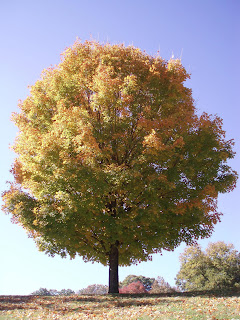
I am fascinated by trees.
The larger and more gnarled they are, the better. One of the reasons I like winter is because of how bare branches look against the sky.
Oaks and other hardwoods are my favorites. I like the sturdiness of Quercus alba, the white oak, and the compact, rounded nature of its leaf lobes. My front yard contains a lovely white oak commonly referred to as a "pasture tree." It is tall and its branches are very well proportioned out in a rounded form because it was not competing for light with any other trees as it grew. White oaks (and other tree species) in more dense areas have branches that grow upwards, almost parallel to the trunk. Mine has lots of perpindicular branches, which are lovely to sit in.
 I have named this tree Zemyna, after the Lithuanian goddess of nature. That's her at right, in winter.
I have named this tree Zemyna, after the Lithuanian goddess of nature. That's her at right, in winter.I enjoy the stature of the huge Northern red oak (Quercus rubra) in my backyard--so close to the deck that I can begin a climb from there. It's leaves are pointier and larger than the white's, and its branches are thick and hardy. They grow more parallel in general, but the tree doesn't have a distinct shape, really. I find her aesthetically pleasing anyway. Her name is Hannah.
Below is Hannah in February, at night, and in summer.



(The white rope hanging from Hannah is my static climbing line. More on that activity later.)
My favorite oak tree ever is the mammoth Live oak (Quercus virginiana) known as Treaty Oak in Jacksonville, FL. It is said to be over 200 years old, with a crown at least 145 feet around. It's an incredible tree to behold, with dozens of low-hanging branches that are thicker around than many trees' main trunks. Many touch the ground.
Other hardwood favorites that appear in my yard are American beeches, with huge, straight trunks, smooth bark the color of a newborn Weimaraner, and oval leaves with sawtooth edges, and a gangly Black cherry (Prunus serotina) that has never produced fruit and is stunted because it lives literally at the feet of a yellow pine. But it perseveres.
I also have a couple of stately Tulip poplars, a Southern Magnolia (whose branches are fabulous for no-rope "freeclimbing"), and a red maple (acer rubrum). We planted the maple just 4 years ago, and it has not yet had the brilliant fall foliage I so crave. But I know it will come.

Left: A "pasture" maple at a park near me.
Below: When I take a nature walk, I am often looking up, into the canopy.

Pasture trees are also called "wolf trees."
ReplyDeleteSometimes you will see a very old spreading oak (maybe a sycamore, tulip poplar, or beech, but usually an oak around here) in the third-growth forests here, with a trunk four times the diameter of the "large" trees around him. Grandpa wolf tree grew up in a pasture or was left in a clearcut as a sapling 100 years ago or more, and the forest has regenerated around him.
We have at least three on our acreage, and sadly lost one more to the wind two years ago. The trunk is so large, no one can cut it to remove it.
Cool! I didn't know that.
ReplyDeleteI hate, hate, hate when living old-growth trees are felled by storm or human hand. I know it is sometimes necessary, but when it appears to be for no real purpose, I am saddened.
The current figure is that Atlanta loses 50 acres of tree canopy every day. Total bummer.